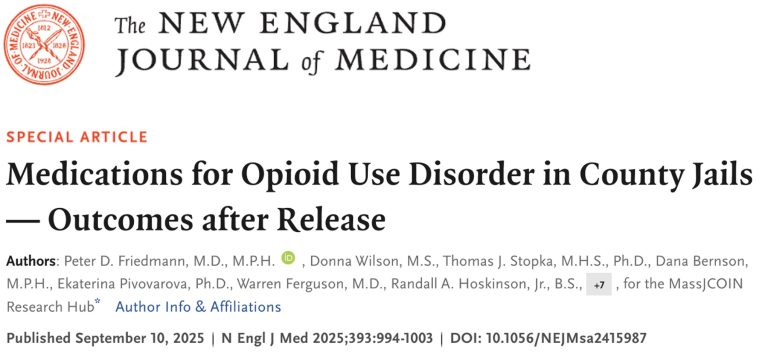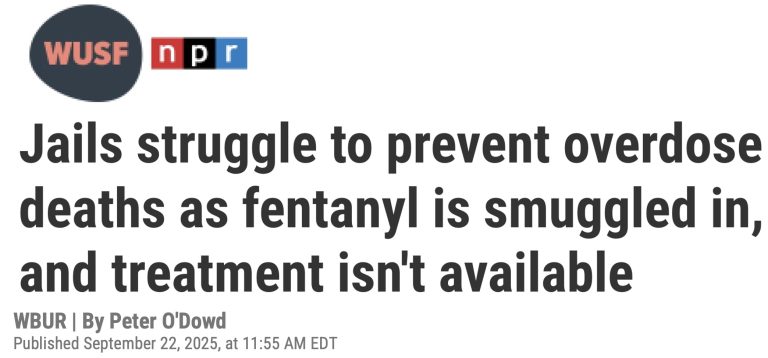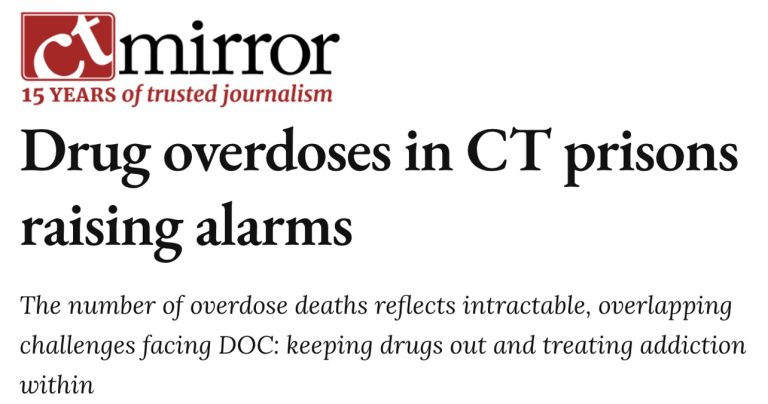NEW RESEARCH, CONSISTENT OUTCOMES OF NO BENEFIT: MEDICAL OPIOID CRISIS TREATMENT EFFECTS POST JAIL RELEASE
Are opioid users engaged in community treatment services no more likely to be revived by Narcan? Lacking evidence for that, claims of benefit from gold standard treatment are lethal medical misinformation.
by Clark Miller
Published October 3, 2025
Let’s keep this simple.
It is simple.
The new study, published in the New England Journal of Medicine (NEJM) behind a paywall, looked at outcome measures post-release for opioid users started on medication for opioid use disorder (MOUD) in Massachusetts county jails over 2019 to 2020.
The research article as we shall soon see is indeed, in keeping the The Journal’s historical position in America’s opioid crisis, a “SPECIAL ARTICLE”.
Abstract
BACKGROUND
In 2019, seven county correctional facilities (jails) in Massachusetts initiated pilot programs to provide all Food and Drug Administration–approved medications for opioid use disorder (MOUD).
METHODS
This observational study used linked state data to examine post release MOUD receipt, overdose, death, and reincarceration among persons with probable opioid use disorder (OUD) in carceral settings who did or did not receive MOUD from these programs from September 1, 2019, through December 31, 2020. Log-binomial and proportional-hazards models were adjusted for propensity-score weights and baseline covariates that remained imbalanced after propensity-score weighting.
RESULTS
The study cohort included 6400 persons with probable OUD: 2711 (42.4%) received MOUD in jail and 3689 (57.6%) did not. Among persons treated with MOUD in jail, 67.9% received buprenorphine, 25.7% received methadone, and 6.5% received naltrexone. Treated persons were more likely than those not treated to be White (75.4% vs. 58.1%), to be sentenced (31.6% vs. 13.2%), to be receiving MOUD at jail entry (73.7% vs. 17.1%), and to receive MOUD during the first 30 days after community release (60.2% vs. 17.6%; adjusted relative risk, 1.44; 95% confidence interval [CI], 1.38 to 1.50). Only 50.4% of MOUD recipients engaged in MOUD treatment for 75% of the first 90 days after release, and 57.5% were receiving MOUD at 180 days. Receipt of MOUD in jail, as compared with no such receipt, was associated with lower postrelease risks of fatal overdose (adjusted hazard ratio, 0.48; 95% CI, 0.36 to 0.64), nonfatal overdose (adjusted hazard ratio, 0.76; 95% CI, 0.68 to 0.85), death from any cause (adjusted hazard ratio, 0.44; 95% CI, 0.35 to 0.56), and reincarceration (adjusted hazard ratio, 0.88; 95% CI, 0.81 to 0.94). The incidence of hospitalizations did not differ substantially between the two groups.
CONCLUSIONS
Receipt of MOUD in jail was associated with an increased likelihood of postrelease MOUD initiation and decreased risks of overdose, death from any cause, and reincarceration. (Funded by the National Institutes of Health and others.)
The setting (Massachusetts correctional facilities and release communities) and time frame are uncannily congruent with this previous study, deconstructed here, with a big difference: subject sample size for our current study was “6400 persons” and in that previous study was “15,225 adults”.
Almost as if a data set was manipulated and reanalyzed post hoc, as happened here, with hopes of different outcomes. But let’s not go there, yet.
We were going to keep this simple.
1.
MOUD substitute opioids methadone and especially buprenorphine (Suboxone) have for decades had integral roles in thriving prison and jail economies of illicit opioid use – described here (scroll down), and here, and here – and fatal overdose as reported recently for Connecticut’s expanding corrections program of dispensing to incarcerated persons the medically-dispenced opioids fueling an increasingly worsening crisis.
2.
The bulletproof, game-changing 30-day injectable buprenorphine formulation – “Sublocade” – used in jails and elsewhere, not able to be abused, diverted, or used like other forms of bupe as currency for fentanyl, is established as a treatment failure.
3.
Beginning decades ago and with accelerating urgency and success over recent years, distribution, community saturation, and provision of overdose-reversing naloxone (Narcan) through services surrounding community treatment for high-risk opioid use have become standard and pervasive, established as accounting entirely for recent drops in opioid deaths.
4.
Those trends hold true for study state Massachusetts, where Narcan use was increasing dramatically beginning pre-pandemic years. Points of contact for Narcan acquisition include pharmacies, treatment service locations, and “human services workers and other community service professionals“.
5.
As explained in this post and this, study individuals engaged in treatment who regularly encounter services and contacts including pharmacies, medical treatment appointments, community supervision contact (parole or probation), peer supports, case manager contact, counseling, and ancillary supports including recovery-friendly vocational training settings and services, work environments supporting persons in recovery, or “halfway” housing or other supportive or group housing post-incarceration would predictably be exposed to continued support for naloxone provision, training, and replenishment in addition to being in treatment-related settings where Narcan is more likely carried and used. There is no reason to predict that their high-risk opioid use would decrease, due to gold standard treatment failure, and incontrovertible reason to believe they are more likely to be proximate to Narcan when needed, compared to the study control group not engaged in treatment and related community support services.
6.
Associated with and due to the widespread successful provision of Narcan to community-level and treatment-associated supports and services, it is established by consistent reports that increasingly data for incidence of reversal of potentially lethal opioid overdose are known, significant undercounts. That is, nonfatal opioid overdoses = high-risk opioid use = gold standard treatment failure are increasingly underrepresented.
To make the inescapable clear:
Lacking compelling evidence that probability of Narcan exposure, with higher incidence of unreported saves and reduced deaths, IS NOT differentially greater for a population engaged in treatments, services, and related community supports compared to a group not engaged (point 5, above) – lacking that, the assertion of medical treatment benefit in this study and those like it constitutes lethal medical misinformation.
Lethal of course, related to the established role of that gold standard treatment in fueling a worsening crisis.
And what about opioid-related hospitalizations?
Differential naloxone provision and effects are clearly a confounding factor in this type of study, based on established roles in reducing opioid overdose deaths incorrectly attributed to treatment effects and in driving underestimates of frequency of nonfatal opioid overdoses, otherwise a valid measure of high-risk opioid use.
But we would not expect differential treatment versus control group effects due to Narcan involvement to necessarily affect a different measure reported in this study: hospitalizations of subjects in treatment versus control groups.
While Narcan reverses potentially fatal opioid overdoses, it does not prevent severity of overdose symptoms and effects (increasingly complicated by presence of high potency additional opioids or tranquilizers in, typically, fentanyl) from requiring hospitalizations, events that unlike community reversals, always become part of a searchable record.
In this study, there was no difference in incidence of hospitalizations of high-risk opioid users treatment versus control, the opposite of what is predicted if there is benefit from applied treatments, reduction of high-risk opioid use the only mode of benefit for expert gold standard treatments.
That outcome tells us something.
Lacking compelling evidence that probability of Narcan exposure, with higher incidence of unreported saves and reduced deaths, IS NOT differentially greater for a population engaged in treatments, services, and related community supports compared to a group not engaged, the assertion of medical treatment benefit in this study and those like it constitutes lethal medical misinformation.
Outcomes of the study we examined here, like those for correctional systems in Rhode Island and in Connecticut, where medical dispensing of opioids is driving overdose deaths in prisons, point consistently to expert gold standard treatment lethal failure, as do outcomes for the safest formulation of buprenorphine, also used in prison and jail settings.
Two recent reports on prison economies of high-risk drug use are recaps of that failure.
Across the country, drugs are commonly smuggled inside correctional facilities, which contributes to people overdosing and dying in custody.
“This is a nationwide issue,” Michael Dawson, deputy chief at the Maricopa County Sheriff’s Department, said. Its jail system in Phoenix is one of the largest in the country.
“We have only seen it grow through the opioid epidemic,” Dawson said. “We’ve seen everything from a few pills and some powder coming in, all the way up to 300-plus pills smuggled inside someone’s body cavity.”
From the recent NPR piece, nationwide, fentanyl is widely available in correctional settings, and opioid overdose and deaths are increasing.
And, that headline is a lie, that “treatment isn’t available”. We know that because it has been established for decades (see, for example links in point 1. above) that buprenorphine (bupe) has been easily available and an integral element in prison drug economies. So, just as outside of prisons, where illicit bupe is easily available, 24/7, on the street, it is as well in prison where anyone wanting to start use of the medical cure – just a tablet or strip or two a day to cure their opioid addiction – can easily do so. There is no shortage of America’s expert gold standard cures inside of prisons or outside.
Despite the easy availability of not just fentanyl but also its cure, overdoses and deaths are mounting
And?
Methadone and Suboxone are serious drugs in their own right that can be smuggled from a jail’s clinic into the housing units. Jail administrators and people with experience in custody told Here & Now that the drugs are in high demand on the black market in jails.
“Fifty percent of the people we start on Suboxone are removed from the program because of diversion,” said Bruce Herdman, chief of medical operations at the Philadelphia jail complex.
That means those gold standard medical cures are being traded for fentanyl to get high, or to someone who wants to avoid being dopesick for a while or who wants methadone or bupe to show up in their drug screen when they get released and on supervision.
And?
In response, he said the jail recently started using an injectable form of the drug.
Right, “Sublocade”, the 30-day injectable formulation established as failing, predictably.
The Connecticut report, also from September of this year, also highlights the predictable role of medically dispensed opioids in overdose deaths in Connecticut prisons, where their dispensing has increased dramatically.
To address the pervasiveness of addiction in its facilities, the Department of Correction administers a program known as medication assisted treatment, or MAT. The program launched in 2013, when DOC began a pilot program at the New Haven Correctional Center.
MAT provides medication like methadone and buprenorphine, which suppresses withdrawal symptoms for people addicted to heroin or opiates. The program has expanded over the years, and as of last year some type of MAT existed in 10 of Connecticut’s 13 correctional facilities.
That’s 12 years of increasingly provided gold standard medical cure to high-risk opioid users. There must be some evidence of benefit from that, right?
There is, right? With evidence that any decreases in opioid-related deaths are NOT due to differential provision and proximity of subjects released to treatment, medical, and community services and supports resulting in higher probability of naloxone reversals of overdose = high-risk use? That type of necessary evidence?
Each facility has a supply of the anti-overdose medication naloxone and at least one substance abuse counselor, who offers counseling to people in the facility who are struggling with substance use.
But incarcerated people in Connecticut prisons are dying from overdoses often from controlled substances they were prescribed. …
While many of the overdose deaths in the last three years in the Department of Correction were the result of overdoses on street drugs, Tyler Cole’s case was different. According to the medical examiner, Cole’s death was from a combination of methadone and antipsychotic drugs he was prescribed, which was being administered while he was at Garner. …
Just two days before Cole’s death, on July 19, 2024, 30-year-old Ronald Johnson also died of a methadone overdose at Garner. Johnson had been transferred to Garner from Riker’s Island prison in New York.
More on the “miracle molecule” methadone, here –
Upcoming Post at A Critical Discourse:
“NEW RESEARCH: OPIOID CRISIS “MIRACLE MOLECULE” METHADONE PREDICTABLY TIED TO MORE OVERDOSE DEATHS”
The predictable failure of medical provision of substitute opioids started in correctional systems is consistent also with additional, independent valid measures of expert treatment failure to curb high-risk opioid use including incidence of injection-related infections disease (here and here, and here for example) and of random workplace drug screens for presence of fentanyl.
Despite the most determined efforts of America’s medical/media collusion, a persistently worsening lethal epidemic is not easy to hide, as we are beginning to see.









